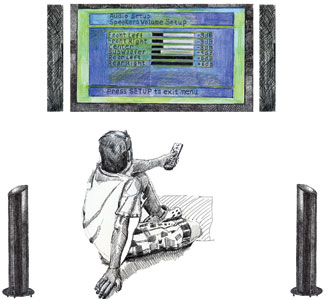It's All Right to Be Wrong Page 2

Multi-Channeling Stereo
Some will say that music is recorded in the holiest of holies, the ever-to-be-revered-and-sanctified duality of the left and right channels, and that listening to music in anything besides straight, totally unadulterated stereo is a mortal sin. Sure, there are times when I sit down with a tumbler of Knob Creek and want to listen to Miles Davis in 2-channel. But there are many other times when I fill my entire room with sound when I want to enjoy the sweet, life-in-the-Matrix simulation that is Dolby PLIIx Music or SRS Circle Surround II. Or when I've got people over and need a 7-channel stereo cocoon of sound. And if you feel like taking things further by using your receiver's surround modes to simulating Lady Gaga in a Vienna concert hall, Drake in a Tokyo church, or Bach through the P.A. at a Yankees game, go ahead. But don't expect me to applaud.
Monkeying with the Aspect
There are evangelists in this industry who say anamorphic lenses are an abomination that only add distortion, ruin fine detail, and affect color accuracy. And to that I say, "Okay. Maybe. So what?" I have an anamorphic lens. And I love it. When those black bars disappear and the image goes from 92-inch 16x9 to 115-inch 2.35:1, why, I feel like a regular Caesar. Would the image look better if I had two separate projectors, one calibrated for 16x9 and another for 2.35:1? Probably. Would I still have a wife in such a situation? Questionable. Under this heading, I'm also giving you the permission to use your TV's Aspect button to select things like Natural Wide or whatever turns 4x3 programming into a 16x9 shape. If you hate the black bars on the side so much, get rid of them. There, see - you're feeling less oppressed already!
Taking the Color to 11
I don't have the space here to go into the CIE Chromaticity Chart or the fineries of Rec. 709 color points, but suffice it to say that there's an established and "correct" point of red, green, blue, etc. And videophile purists crave a display that sticks to those points like a supercharged neodymium magnet. However, many new displays - including Runco's Q750i, Sharp's Quattron Series LCDs, and Mitsubishi's LaserVue TV - have the ability to produce a much wider color gamut, delivering far more saturated reds, blues, greens and "Oh, my!" yellows. Are all these "extra" colors technically accurate? Hells to the no. Will you want to use them for all viewing? Probably not. But do they make images pop off the screen and work great for some viewing? Well, these colors don't go to 11 - exactly one louder - for nothing!
3D-izing 2D Material
This is a relatively new one, but it will surely become increasingly common and will likely be eschewed (I believe the technical term is "pooh-poohed") by the Great Pumpkin. As I write this, there are fewer than five 3D Blu-ray discs. So, what do you do with your new 3D TV after you declare that you'll kill someone if you have to watch Cloudy with a Chance of Meatballs again? You convert regular TV programming into 3D. Will it be perfect? Doubtful. Will there be the occasional weird artifact? Surely. Will you look like Bono wearing your 3D glasses constantly indoors? Probably, but that's a risk you'll just have to take.
- Log in or register to post comments




































































